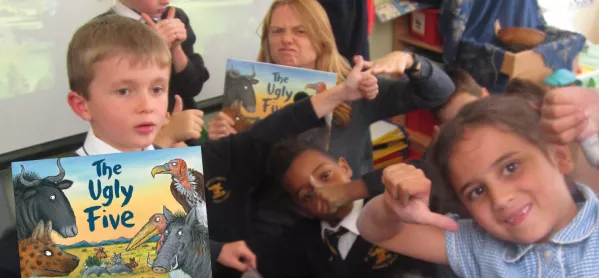- Home
- Book review: The Ugly Five
Book review: The Ugly Five

The Ugly Five
Julia Donaldson and Axel Scheffler (illustrator)
32pp, £6 (hardback)
9781407174198
A new book by Julia Donaldson is always a thrilling event for a primary-school librarian. Her books - the best-known of which is The Gruffalo - are guaranteed crowd pleasers, easy and fun to read aloud. They are often used by our key stage 1 teachers as the basis for a term’s project work. She is also one of those rare picture-book authors whose name the children recognise, and they are genuinely excited when she publishes a new book.
So it is with a heavy heart that I have to report that The Ugly Five was something of a disappointment. For a school librarian, this is as close to sacrilege as you can get.
The book is about the animals known on safari as the Ugly Five - the cosmetically challenged companions of the more famous Big Five (lion, leopard, rhinoceros, buffalo and elephant). They are the wildebeest, warthog, spotted hyena, lappet-faced vulture and Marabou stork.
Wildebeest starts the story wandering through the African savannah on her own, proudly singing, “I’m the ugly one, I’m the ugly one, I’m the ugliest animal under the sun.” She comes across hyena and is happy to become the ugly two. They then meet vulture and become the ugly three, and so on. At the end of the book, the Ugly Five meet with their babies, who declare that their parents are just perfect as they are and that to them they are the Lovely Five.
As always, Julia Donaldson’s rhyming is fabulous. It is never forced or awkward and, with its rhythm and wit, is always a pleasure to read. The illustrations by Axel Scheffler are again lovely. His style is instantaneously recognisable and very child-friendly. The message of the book is charming - that beauty is indeed in the eye of the beholder and that we are perfect just the way we are.
So why didn’t I like it as much as her other books? I think there wasn’t enough plot to keep the story moving along. I read it to six groups of key stage 1 children, and the Year 2s were definitely a bit twitchy. The rhyme is incredibly clever, but there is a lot of it and so for a picture book it is quite wordy. Also, there was no dramatic tension. In The Gruffalo, we are worried that the mouse will be eaten, in Room in the Broom, the witch needs to be rescued and in Tiddler, the protagonist needs to get home. But in The Ugly Five, there are five animals out for a walk and then they meet their children.
Everyone enjoyed hearing about the Marabou stork, which poos on its legs - apparently to cool itself down - and there was fascination about exactly what the meat was that the hyena and the vulture were eating. One nature-documentary watching child thought that the answer would not please the wildebeest.
When asked to vote thumbs up or thumbs down, Dragonflies class (Year 2) polled a mixture of thumbs up, thumbs down and thumbs in the middle. Dominic thought it was boring, but liked the pictures of the funny animals. Brandon thought it was too long and wasn’t funny. Maia liked “seeing animals I’ve never seen before”.
Oliver thought it was mysterious. Sonny pondered the message of the book and told me: “At the end of the book they weren’t really ugly at all - they were lovely.”
Edward listened carefully and wisely pronounced: “It’s good that they don’t care what they look like, but I prefer The Gruffalo.”
Finley wasn’t keen at all, and thought it was “boring, they don’t do anything”.
Mason wanted some superheroes in the story, whereas Michelle thought: “It was fun. I liked when they found their babies and the stork who pooed on his legs.”
There would be lots of ways to incorporate The Ugly Five into teaching. It would fit beautifully into any topic work on Africa or animals, particularly looking at how animals are suited to their habitats and the idea of food chains - both the vulture and the hyena are seen scavenging - and also how animals grow.
There are strong PSHE messages about celebrating everyone as they are and not judging on appearance. Many of the children commented on how important it was to love everyone, no matter what they look like. The book would also be a good starting point for a discussion on family and love within the family. As a faith school, we could then expand this further to discuss the concept of how we are all unique and yet loved by God.
Still, it pains me to say it, but I thought it was ever so slightly dull. I just don’t think it is destined to be a classic.
Sarah Ormes is school librarian at St John’s Catholic Primary School in Bath
Keep reading for just £1 per month
You've reached your limit of free articles this month. Subscribe for £1 per month for three months and get:
- Unlimited access to all Tes magazine content
- Exclusive subscriber-only stories
- Award-winning email newsletters



